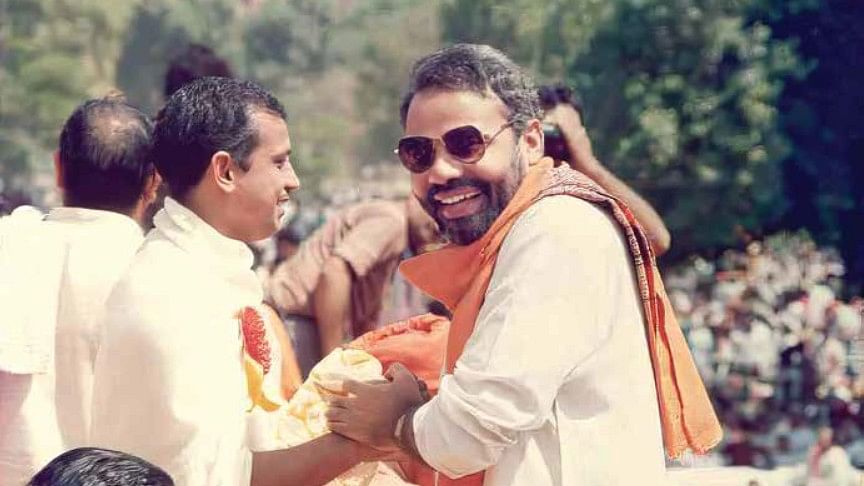
Narendra Modi in rally organised by the VHP in 1991.
Credit: X/@modiarchive
The consecration of the Ayodhya Ram temple is scheduled to take place today. Prime Minister Narendra Modi is the chief ‘yajman’ or the host of the Ram temple consecration, and it will be on his behalf that the prayers are offered. Track our full coverage here.
Modi is very much at the forefront of this event, now, but the PM has a long and mired history with the Ram Janmabhoomi movement. Modi, before being deputed to the BJP, was an RSS cadre - an organisation already deeply involved in the Ram Janmabhoomi movement.
Narendra Modi listening to a speech as an RSS cadre.
Credit: X/@modiarchive
Here's a timeline showing Modi's role in the Ram temple movement:
1980s:
After he was made the organisational secretary of Gujarat, Modi had to make arrangements for Advani’s Gujarat leg of the Ram Rath Yatra. ‘Modi with his careful and deliberate thoroughness organised the Gujarat leg of the yatra through 600 villages, and followed it as far as Mumbai’, Andy Marino notes in Narendra Modi: A Political Biography.
Apart from that, he was extremely active during the Ram Janmabhoomi movement, trying to get support from various villages in the state. Back in 1989, Modi had helped the VHP organise the 'Ram shila pujan' where the group collected bricks from people for the proposed Ram mandir.
Narendra Modi speaking during the Ram shila pujan.
Credit: X/@modiarchive
One of Modi’s speeches ‘Lok Adalat Main Ayodhya’ (Ayodhya in people’s court) was reportedly very well received and thousands of copies of cassettes were sold.
Modi organized Lok Shakti Yatra, connecting to almost 10 lakh people, 1989.
Credit: X/@modiarchive
1990s:
In September 1990, the Somnath-Ayodhya Ram Rath Yatra commenced and Narendra Modi was Gujarat BJP's General Secretary. He played a major role as the charioteer for the Gujarat-leg of the Yatra.
Modi speaking during the Ram Rath Yatra, 1990.
Credit: X/@modiarchive
Modi was also instrumental in a 1991 signature campaign that the VHP launched for the Ram temple. He has also been photographed at a 1991 VHP event at the Delhi Boat Club aimed at amassing support for the Ram mandir movement.
Modi at a rally organised by VHP at the Boat Club in Delhi to support the Ayodhya movement. He worked as a volunteer worker of the 'Ram Janmabhoomi' movement.
Credit: X/@modiarchive
In January 1992, Modi had also made a vow, that he would not return to Ayodhya until the temple was made.
In December the mosque was brought down in the presence of senior BJP leaders like Advani, Joshi, and Uma Bharti.
In February 1993, Modi started to collect signatures from different villages in favour of the Ram temple construction, by June that year, Modi had gotten 10 crore of them.
Modi in 1993, displaying the signatures he collected.
Credit: X/@modiarchive
2000s to present day:
In 2002, the VHP reinfused life into the demand for the Ram mandir again, kar sevaks started flocking to Ayodhya again.
On February 27, 59 pilgrims and kar sevaks were killed in the Godhra train incident, and the riots in its wake turned the streets red. Narendra Modi was, of course, the chief minister of the state at the time.
Modi's road show after taking oath as Gujarat CM.
Credit: X/@modiarchive
After Modi came to power, in 2014, he gradually began to shift to a legal solution for the Ram temple issue - a marked departure from the BJP’s official stance in 1993 that eschewed the possibility of legal resolution.
The VHP, too, in 2014 announced the drive to collect stones for the Ram temple. In 2015, the organisation held ‘Ramotsav’ from March to April, to raise its voice for the mandir.
In 2018, RSS chief Mohan Bhagwat urged the Modi government to bring a law for the construction of the Ram mandir, during his Vijayadashami speech.
In 2019, the Supreme Court decided that the disputed land would be handed over to a trust set up by the government to construct the Ram mandir. This judgement came in November, six months after Modi resumed office for his second term as India’s PM.
Modi before assuming second term as PM.
Credit: X/@modiarchive
After the SC decision, Modi came to the forefront again - announcing in the Parliament - in February 2020, the formation of the Shri Ram Janmabhoomi Teerth Kshetra Trust which is managing the construction of the temple now.
In August, that year, Modi laid the foundation stone and the bhoomi pujan was performed. This marked the official start of the construction of the Ram mandir and since then, work has carried on in full swing.
Two years down the line, the trust reported that 50 per cent construction work for the mandir was complete. In 2023, the trust shared that 70 per cent of the work has been completed and that the temple would open in January 2024.
The consecration is today. A temple official shared that the first and second floors will be completed by December this year.
Prime Minister Narendra Modi along with RSS Chief Mohan Bhagwat performs Bhoomi Pujan at ‘Shree Ram Janmabhoomi Mandir’, in Ayodhya.
Credit: PTI
Ahead of the consecration, Advani wrote in the 'Rashtra Dharma' magazine, “Destiny had decided that a grand temple of Lord Ram will be built in Ayodhya, and it chose Prime Minister Narendra Modi for this.” Given Modi’s long association with the movement, it was perhaps written in the stars.
The entire temple is expected to be completed by 2025.
PM Modi releases commemorative postage stamps on Shri Ram Janmabhoomi Temple and a book of stamps issued on Lord Ram around the world.
Credit: PTI Photo